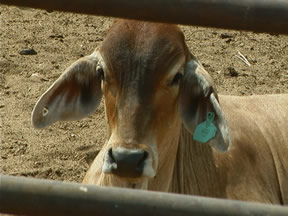
Introduction:
During
our stay at Moolooloo Station we got to interview the Station Manager
Mark Clifford. One of the questions we asked him was how important
it was to protect the land from overgrazing or soil erosion from
the presence of cattle. This was his answer:
“Well
it’s critical and is a fairly large part of our job. As a company
we use things like satellite imagery. There’s a Northern Territory
range management body that actually comes out here and monitors
certain sites on an annual basis to make sure there’s no pasture
degradation (nonproductive). Obviously we also keep a close eye
on the paddocks. There’s a scientist within the company who
does a lot of work looking after the pastures. “
The reason cattle ranching in the
Victoria River basin has been so successful since Nat Buchanan first
stocked nearby station Victoria River Downs in 1884 is largely because
of the protein rich grasses that thrive on the black clay soil and
the amount of rainfall the area receives each year (around 28-30
inches per annum). But, during drought years, when reduced vegetation
in turn means the soil is more open to erosion from the wind, the
land is in serious danger of becoming unproductive. Should a particularly
dry winter (April through October) be followed directly by a particularly
wet summer (November through March), the topsoil will be further
eroded by floodwater. Add cattle to the equation, especially more[than
the pasture can hold], and you could be in trouble. Mark continues:
 |
“It’s
not impossible to have a drought year, in which instance we have
to look quite closely at our cow/calf unit per square kilometre
– normally around 6 to 1 on Moolooloo. In drought years we’d
have to look at reducing this figure to maybe 3 or 4, or even less,
and taking the surplus animals off the land.”
It seems that monitoring the pastures,
either by satellite imagery from space or by a scientist on the
ground, is the method that Mark uses to safeguard his pastures.
Data from monitoring procedures can be used in conjunction with
computers to build ‘models’ from which he can make range
management decisions, before it gets too late and erosion sets in.
Vocabulary:
- drought
- vegetation
-
surplus
- erosion
Materials:
- Guidebook
to rangeland grasses and vegetation
- Landsat
photos for comparison of land use over time
- Journals
to record data and observations
Preparation:
- Study
a variety of photos showing ‘before and after’ pictures
of reclaimed pasture land. (A local agriculture office could provide
resource materials)
- Research
native grasses in your area. Make a list of those grasses.
- List
the species that have been introduced from other areas of the
country.
Procedure:
- Investigate
the climate in your area. Make a bar graph showing rainfall for
each month of the year.
- Determine
the most common types of native vegetation and gather samples.
Identify those grasses which are most commonly found in local
pastures.
- Identify
the weeds that are most common. Determine if they are native or
are introduced species.
- Collect
and dry samples of the vegetation, then classify and categorize
the samples into two categories of native plants and introduced
species.
- Record
observations in student journals.
- Have
a local range management expert speak to the class about the effects
of drought and excessive moisture on vegetation.
Analyze
and conclude:
- Identify
grasses that thrive in the particular climate in which they live.
Recognize that certain grasses will be more productive in proportion
to the amount of rainfall that the region receives each year.
- Research
introduced species, such as Kentucky Bluegrass, in a semi arid
environment. Discover that more water is needed to insure that
the grass survives.
- Make
a graph or a chart listing the types of grasses in your area.
Compare and contrast the native grass with the yearly rainfall.
Compare and contrast the introduced species with the extra water
that is needed to supplement yearly rainfall.
- In
journals, record observations as to the effects on the environment
that introduced species can produce. Be sure to include the extra
water usage that may be needed to keep introduced species of grass
alive in non native environments.
Management
Tip: use the print feature
in your browser to print this page.
|
